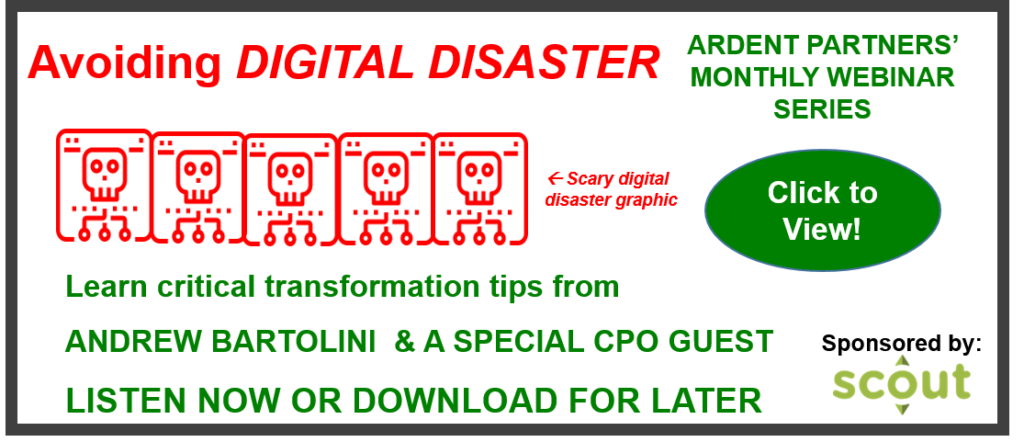If you missed yesterday’s webinar, The Procurement Leader’s Guide to Digital Transformation, you missed a really interesting presentation (if I do say so, myself) and a scintillating discussion with the wonderful and talented Linda Chuan.
Digital transformation has been and remains a hot topic for procurement teams and for business leaders everywhere. But, I will be honest, my initial reaction to the term about nine or ten years ago was that it was simply a dressed up way to describe a process automation project… it wouldn’t have been the first time a stale business concept was re-packaged as the hottest new trend. But, my initial reaction was wrong. After years of working with and counseling procurement organizations on solution selection, technology strategy, and deployment plans, I’m convinced that a digital transformation is a level-step up from the process automation projects that I used to oversee in the early aughts.
I usually pride myself in developing clear definitions, frameworks, and models to help organizations access important strategies and concepts. As I started to craft a definition of digital transformation, however, I found a pretty good one from Saleforce.com that more than accomplishes the goal. I never like using third-party information or ideas in my research and I actively try to avoid reports and the random blogs from rival firms… but, maybe because it was late one evening, I decided to use it and avoid reinventing the wheel.
Digital transformation is the process of using digital technologies to create new — or modify existing — business processes, culture, and customer experiences to meet changing business and market requirements. This re-imagining of business in the digital age is digital transformation.
The digital transformation of a procurement department is an opportunity to use technology as a means to re-imagine the organization’s entire scope of operations and how it performs. Unlike the process automation initiatives that preceded it, a digital transformation does not view technology as a process enabler, but rather, as the fundamental process going forward – it is the alpha and omega and everything in-between.
A successful digital transformation requires many things including sponsorship, effort, collaboration, vision, expertise, and a supporting technology infrastructure; superior program design also remains a critical element in the speed and impact of the initiative. On the webinar I re-engineered a digital transformation (from business case to fully using the solutions to drive agility, innovation, and creativity. Then, Linda put one (a digital transformation) together for the audience with great tips and strategies like using the project team stakeholders as a way to gain longer-term end-user buy-in and managing the entire project with adoption as a focal point.
Late last week, as I was starting to to pull together ideas for the presentation, I realized that it is important to address the ways to avoid failure. Readers of my CPO Rising 2017: Tools of the Trade report will recall that I believe that individuals generally place more value on not losing than on winning (my view is based on many human behavior studies that indicate this). This is known as loss aversion and it frequently leads to risk aversion, which is a well-known concept in business. The point is not that the best business leaders are more rational decision-makers (although that is true) or that they are less risk- averse. The point is that it is helpful to understand the personal and organizational decision-making process in place and the factors that influence it to better understand the mindset of the procurement organization. As such, I decided, somewhat at the last minute, to try to ease the minds of the risk averse among us and list out a few ways to avoid digital disaster:
- Avoid selecting the wrong solution and solution provider – there are many ways to avoid a feature gap issue and ensure that the functionality you need will be there in the deployed system including tapping into third-party expertise (anyone working on an AP Transformation? – click here if yes!– you’re welcome)
- A digital transformation is achievable, but doing so without executive support and some level of mandate increases the degree of difficulty substantially – Use the business case process to engage and expand the stakeholder list and lead a charm offensive with the executive roster.
- Attempting to model processes that are too complex. Put the process binders away. Seriously, just stop! Use the initiative to re-imagine how the work is being done.
- Lack of internal support – According to Jeff Immelt, keynote speaker at the Spark by Scout conference – one key in transformation is for executives to absorb user fear because fear is such a huge obstacle.
There are others that you can hear on the webinar recording found here or by clicking the image below. Listen now or download and save it for later – It will be available for a short time only.


